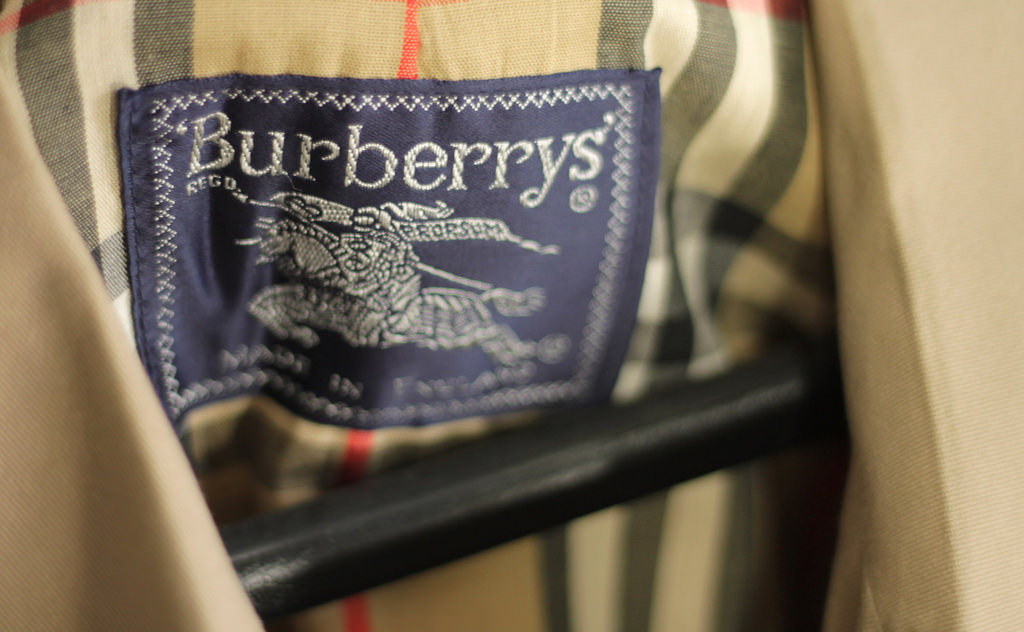Burberry is checking Target for using its signature check. The luxury brand, maker of the most iconic trench coat this side of the military industrial complex, filed suit against the big box retailer earlier this month, citing “repeated, willful, and egregious misappropriation” of their “famous" and "iconic" pattern.
The suit seeks $2 million in damages for each unique violation and, according to the plaintiff, these violations have been frequent: Target has used the offending pattern on eyeglasses, water bottles, luggage, and, most gallingly for Burberry, scarves.
For both parties, this isn't their first rodeo. Burberry has settled out of court with JC Penny in 2016 and TJX in 2010; Target settled out of court with Coach after similar accusations of print-lifting, in this case with handbags.
So now Target will likely have to get out its checkbook to account for its misuse of the check look, but how did we get here? How are a few shapes and colors so hotly contested and why would Target ask for forgiveness rather than permission? Follow us along the fashion retail market research runway, as we put on our strategic consulting hat and check out the great check bout.
Fashion Retail Market Research Says Aspirational is Rational
Though couched in legalistic language, Burberry did not skimp on the shade in its complaint, charging, “Although Target’s copycat scarves are of inferior quality, they are superficially indistinguishable from genuine Burberry scarves." Nobody would dispute this in a side-by-side comparison. The lawsuit further accuses Target of neglecting to take action in the matter after receiving a cease-and-desist early in 2017, so ignorance will not be a viable defense.
Burberry's outrage is understandable in context. They, like many a hyper-luxury house, have seen profits fall over the last decade, and just now seem to be turning things around.
They are known for two things, trench coats and the check print. You know the print, we all know the print. It's been around since the 1920s and is easily among the most immediately recognizable patterns in contemporary fashion.
But Burberry is also to blame for its proliferation. The company spent years pounding it into the cuffs and collars of its polo shirts, wallets, socks, and even umbrellas, essentially making a Burberry bubble, devaluing the exclusivity of the pattern originally confined to the interior of its still best-in-class coats. By overexposing the print, it went from a discrete blink-and-you-miss-it lining to an ostentatiously in-your-face declaration of status and, frankly, gaudiness. In a problem that at this point must be far too familiar to our dear readers, what was once aspirational and subtle became common and abrasive.

Under Chief Creative Officer Christopher Bailey, they seem to have turned this around, using the pattern more sparingly and charging more for it.
Their recent showing, which was also Bailey's last in his current role, raised eyebrows with its rainbow themed collection that injected new life into the brand. From a traffic-stopper of a jacket to a subtle, color-infused twist on their check, the new collection reminded Burberry's most important buyers (namely the ultra rich) what they loved about the brand. Coupled with the smashing success of their newest must-have item (real talk: that belt bag is straight-up gorgeous and selling out for good reason!) Burberry seems to be reasserting itself as simultaneously timeless and ultra-modern, and reigning in their excesses.
Target or Bullseye?
The problem with reigning in their excesses is that they are no longer entirely their own. The rapid expansion of the print has trickled down to the counterfeiters and the super counterfeiters, predominately overseas. It’s tough to do too much about overseas manufacturing and digital retail channels…but Target? They put a bullseye on themselves, becoming a reachable whipping boy to take the lash for all of forgery’s sins.
This is especially interesting as the line between “inspired by” and “stolen from” has gotten blurrier and blurrier, not only in fashion. Think about the recent controversies regarding music IP, from Sam Smith v. Tom Petty to Pharrell v. Marvin Gaye’s family. With new apps designed to help people emulate expensive fashions for a fraction of the cost (looking at you Kim K, though you should be looking to your man), fashion houses must closely guard their most iconic patterns, cuts, and materials.
How the Check Got Past Checkpoints
So what does Target have to say for themselves? Well, Target's response (to Fortune) was made up of words but said nothing: “At Target, we have great respect for design rights. We are aware of the filing by Burberry and hope to address the matter in a reasonable manner.” Were they choking on the canary in their mouth?
Honestly, though, we have no idea how and why this happened—how did this obviously lifted pattern get past the checkpoints? Maybe it just slipped through the cracks, perhaps it was bounced department to department and nobody noticed. Maybe they just didn’t see the similarities (unlikely). Or perhaps they thought they could not survive without the $13 dollars they charged for each knockoff scarf. They recently raised their minimum wage to $12/hour, and that money’s gotta come from somewhere.
All kidding aside, this was a very un-Target move. With their Lily Pulitzer partnership, among others, Target has tried to become the place to go for fun, exciting, and authentic fashions from known designers. It might not be the same craftsmanship as designers like Isaac Mizrahi’s top-tier lines, but it still has their name on it. Target wants to be honest and authentic about its affordable fashions—the place fashion savvy bargain hunters can be proud to shop. Mixing in knockoffs seems off brand, no?
Indeed, Burberry used this very authenticity in support of their complaint, noting, “Target’s well-publicized history of collaborating with popular brands and fashion designers to promote and sell Target-exclusive limited edition collections further heightens the risk of…consumer confusion.”

Strategic Consulting: Breaking Down Silos
And what of the actual case? Honestly, we will leave that one to the court, though we doubt it will even get that far.
If recent precedent is any guide, Burberry actually has a compelling case. Consider that Christian Louboutin, reigning king of luxury shoes (sorry Jimmy and Manolo, it was a good run!), recently won protection in the US for his iconic red-bottomed (yes, bloody) shoes. Though Louboutin has better guarded his calling card, Burberry's print is no-less iconic.
Under Nos. 4123508 and 3529814, Burberry already holds copyrights in the United States (though just recently lost similar protections in China). So this seems pretty cut and dry, especially considering that other recent offenders like JC Penny have settled out of court under similar legal pressure.
So again, what was Target thinking? We cannot know, but here’s our best guess: It was likely a combination of factors, the result of corporate silos keeping pertinent information from moving freely across the company. Purchasing, merchandising, legal, marketing—it seems likely that the stakeholders never got in a room together to hash this out because, again, we are talking about small potatoes in relation to Target’s bottom line.
Such confusion can be avoided, of course, with a top-tier strategic consultant who can easily suss out any communication and efficiency issues and find ways to break down the barriers between discrete departments with shared responsibilities and interests.
The case itself will be relatively quick. But it is also an opportunity to evaluate how different departments operate, and what weaknesses can be fortified. A check-in, if you will.


